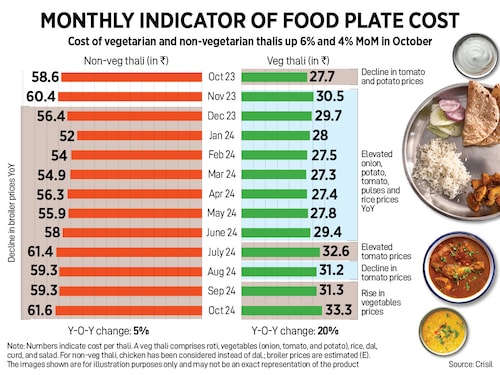How India Eats: Crop damage due to rains heats up thali cost in Oct
Continuous rains in September leads to the price rise of tomato and onion and delays the fresh arrival of potato



Incessant rainfall in September delayed arrivals of key vegetable items like tomato, onion and potato, which consequently increased their prices. Higher demand due to festivals in September and October also affected costs of food ingredients, including pulses.
In October, prices of both home-cooked vegetarian and non-vegetarian thalis increased, shows a Crisil analysis. A vegetarian thali cost Rs 33.3 in October, higher by a whopping 20 percent from same month last year. The same thali cost Rs 31.3 in September, increasing 6 percent month-on-month. The veg thali cost rose due to the increase in prices of vegetables, which collectively account for 40 percent of the cost.
Prices of onion jumped 46 percent while potato surged 51 percent year-on-year in October due to lower arrivals impacted by the incessant rainfall in September. Rainfall in Maharashtra, Karnataka Telangana and Andhra Pradesh damaged crops and delayed kharif harvests by 10 to 15 days, says Crisil, as onion prices rose 6 percent month-on-month in October.

Cold storage stocks of rabi potato, which accounts for 95 percent of its annual production, are declining due to season end, while fresh arrivals will begin from December-January. Similarly, prices of tomato rose more than two times to Rs 64 per kg in October from year-ago period due to rains. The price of tomatoes rose by 39 percent month-on-month in October from Rs 29 per kg in the corresponding month last year.
Crop damage due to rains in September impacted the arrival of tomatoes from states such as Maharashtra, Karnataka and Andhra Pradesh, while the festive demand also exerted pressure on prices. However, with supplies from Madhya Pradesh, Rajasthan and Himachal Pradesh, tomato prices are expected to stabilise in November, says Crisil.
The price of pulses, which account for 9 percent of the vegetarian thali cost, rose 11 percent due to lower pipeline stocks and higher demand during festivals. The prices are expected to slow down from December onwards, once arrivals begin.
Meanwhile, an 11 percent drop in fuel cost—to Rs 803 in March this year from Rs 903 for a 14.2 kg LPG cylinder in Delhi in September last year—prevented further increase in the thali cost.

The average cost of a thali is calculated based on the input prices in north, south, east and west India. The data also reveals the ingredients (cereals, pulses, broiler poultry, vegetables, spices, edible oil, cooking gas) driving changes in the cost of a thali.
A non-vegetarian thali cost Rs 61.6 in October, rising 5 percent from the same month last year. On a monthly basis, the non-veg thali cost increased 4 percent, from Rs 59.3 in September. An estimated decline of 9 percent year-on-year in broiler prices led to a relatively slower uptick in the non-veg thali cost even as vegetables prices rose. Broiler prices account for 50 percent of the non-veg thali cost.
Additionally, vegetable oil prices jumped 10 percent month- on-month in October due to the increase in import duty coupled with a healthy festive demand.
The monthly series "How India Eats" takes a look at how the average price of a food plate in India changes every month, indicating the impact on the common man"s expenditure, by analysing the Indian thali.
First Published: Nov 06, 2024, 12:15
Subscribe Now